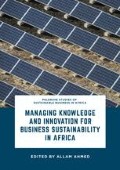Abstract
The purpose of this chapter is to investigate the relationship between labour productivity, human capital and international R&D spillover during the period 1982–2011. It estimates a single equation model which employs long-run cointegration analysis and short-run analysis (ECM). It is based on annual data collected from the World Bank and the Ministry of Planning in Egypt and the OECD database for the period 1982–2011. The results show a conventional result for international R&D and human capital. we infer from the emperical results of this study the significant positive role played by international R&D and human capital on labour productivity. This chapter highlights an important area for policy decision-making which stresses the idea that human capital’s absorptive capacity, enhanced by high-quality education, intensifies the positive effect of R&D spillover on labour productivity. This was determined by our survey of the literature and our empirical model. This chapter takes a different approach from the literature by examining the effect of international R&D spillover and human capital on labour productivity in the Egyptian manufacturing industries. Other studies were conducted by examining the effect of these variables on either total factor productivity or gross domestic product of recipient countries. This study was conducted on a limited scale on Egypt with the research method used in this chapter and with emphasis on human capital.
Notes
- 1.
For more details about this method, see Elshamy (2009). Details of these findings can be interpreted as follows: in the Egyptian manufacturing sector, international R&D has a positive influence.
References
Borras, B., Serrano Domingo, G., & Simarro Parreno, R. (2011). Direct and indirect intersectoral knowledge and labour productivity in the Spanish economy. University of Valencia. Retrieved from http://www.webmeets.com/SAEe/2011/prog/getpdf.asp?p:d
Bouoiyour, J. (2005). Labour productivity, technological gap and spillovers. Evidence from Moroccan manufacturing industries. African Finance Journal, 7(2), 1–17.
Cincera, M., & Bruno, P. (2001). International R&D spillovers: A survey. Cahier Economiques de Bruxells, 69(1), 169–180.
Coe, D., & Helpman, E. (1995). International R&D spillovers. European Economic Review, 39(5), 859–887.
Coe, D., Helpman, E., & Hoffmaister, A. W. (1997). North–South R&D spillovers. The Economic Journal, 107(440), 134–149.
Coe, D., Helpman, E., & Hoffmaister, A. W. (2009). International R&D spillovers and institutions. European Economic Review, 53(7), 723–741.
Costa, M., & Stefano, I. (2004). Technology spillover and regional convergence process: A statistical analysis of the Italian case. Statistical Methods and Application, 13(3), 375–398.
Covers, F. (1997). The impact of human capital on labour productivity in manufacturing sectors of the European union. Applied Economic, 29, 975–987. RePEc:dgr:umaror:1996001.
Elshamy, H. (2009). Productivity growth in the manufacturing sector in Egypt. Conference of the Scottish economic society, held from 22/4/2009 to 24/4/2009, Perth-Scotland.
Gera, S.,Wulong, G., & Frank, L. (1999). Information technology and labour productivity growth: An empirical analysis for Canada and the USA. The Canadian Journal of Economics, Working Paper Series (Canada. Industry Canada), 32(20), 384–407.
Kao, C., Minttsien, C., & Bangtin, C. (1999). International R&D spillovers: An application of estimation inference in panel cointegration. Center for Policy Research Working Paper(4), RePEc:max:cprwps:4.
Litchtenberg, F., & Brouno, P. (1998). International R&D spillovers : A comment. European Economic Review, 42(8), 1483–1491.
McNeil, L. (2007). The international diffusion of technological knowledge: Industry level evidence from Egypt and Morocco. Howard University.Retrieved from http://www.unidep.org/Release3/.../IDEP-AFEA-07-12.pd...
Muller, W., & Michaela, N. (1998). A panel data analysis: Research and development spillover. Economics Letter, 64(1), 39–41.
Sunkwark, N., & Young, S. (2006). International R&D spillovers revisited: Human capital as an absorptive capacity for foreign technology. International Economic Journal, 20(2), 179–196.
Wolf, E., & Ishraq, N. (1993). Spillover effects, linkage structure, and research and development. Structural Change and Economic Dynamics, 4(2), 315–331.
Zhu, L., & Bang, J. (2007). International R&D spillovers: Trade, FDI and information technology as spillover channels. Review of International Economics, 15(5), 955–976.
Author information
Authors and Affiliations
Editor information
Editors and Affiliations
Rights and permissions
Copyright information
© 2017 The Author(s)
About this chapter
Cite this chapter
Elish, E., Elshamy, H. (2017). Absorptive Capacity of Human Capital and International R&D Spillover on Labour Productivity in Egypt. In: Ahmed, A. (eds) Managing Knowledge and Innovation for Business Sustainability in Africa. Palgrave Studies of Sustainable Business in Africa. Palgrave Macmillan, Cham. https://doi.org/10.1007/978-3-319-41090-6_9
Download citation
DOI: https://doi.org/10.1007/978-3-319-41090-6_9
Published:
Publisher Name: Palgrave Macmillan, Cham
Print ISBN: 978-3-319-41089-0
Online ISBN: 978-3-319-41090-6
eBook Packages: Business and ManagementBusiness and Management (R0)

